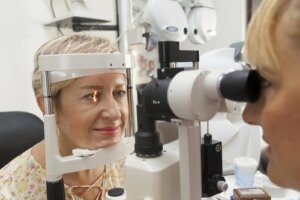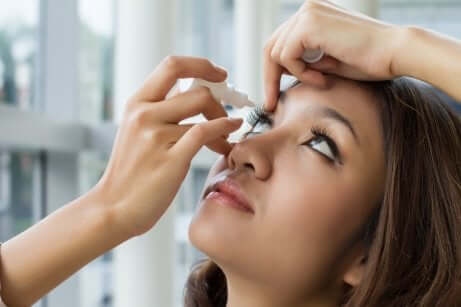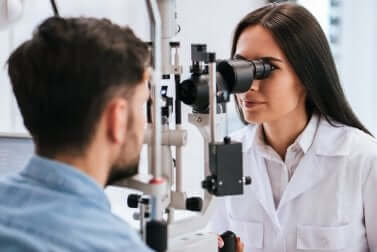High Eye Pressure: Causes and Treatment

When we’re talking about high eye pressure, it means that the pressure inside the eye is higher than normal. The consequences of this pressure aren’t always predictable. Some people have this problem and yet never develop any other issues, while, in other cases, it can lead to total blindness.
One of the difficult things about this condition is that in the majority of cases, it goes unperceived by the person who has it. It doesn’t cause any symptoms, probably until the damage is already done. The only way to detect it is to have periodic checkups.
Some people are more predisposed to suffer from excessive eye pressure. These include people who have a family history of the problem, or of some form of glaucoma. Other risk groups include those over 40, those who suffer from high blood pressure or nearsightedness, or those who have used steroids over a long period of time, for example.
What is high eye pressure?

Aqueous humor is a transparent fluid. If the amount of aqueous humor remains constant in the eye, the eye pressure will be normal. But if fluid production increases, or if it doesn’t drain properly, the pressure will go up. The optic nerve will then be under pressure and this can cause various vision problems.
Did you know: Find Out How the Eye Cleans Itself
If someone has high eye pressure, their risk of suffering from glaucoma goes up by 10 or 15 times. Glaucoma describes a group of serious eye conditions that can lead to a complete loss of vision. That’s why ocular pressure is an issue that shouldn’t be overlooked.
High eye pressure and the absence of symptoms
As we mentioned above, one of the main difficulties with this condition is that, in most cases, it can come up without causing any symptoms. Therefore, the only way to detect the problem is by means of a professional eye exam, with a device called a tonometer.
A tonometer measures the pressure of the fluids in the eye. The levels of the intraoccular pressure (IOP) are measured in millimeters of mercury (mmHg). If the pressure is within a range of between 11 and 22 mmHg, this means the pressure is normal. But if it goes over that, it means the pressure is too high.
Causes

According to a report from the American Academy of Opthalmology, the main factors that lead to the development of this condition are the following:
- Excess aqueous humor production. Aqueous humor is produced in an area of the eye called the ciliary body. If this creates an abnormal amount of humor, the pressure will increase.
- Insufficient drainage of the aqueous humor. The aqueous humor drains out of the eye by means of a structure called the trabecular meshwork. If the drainage isn’t efficient, however, the pressure will go up.
- The effect of medications. Some medications cause an increase in eye pressure, those that contain steroids for instance.
- Trauma to the eye. Injuries to the eye can, in some cases, lead to an excessive production of aqueous humor, or to drainage problems.
- Eye diseases. Eye conditions such as pseudoexfoliation syndrome, pigment dispersion syndrome, and corneal arcus, can tend to increase eye pressure.
You may also like: 5 Effective Remedies for Eye Infections
Available treatment
High eye pressure treatment usually involves medication, laser procedures, or surgical intervention. Of course, your health care professional will be able to determine which option to choose, depending on the characteristics of your case.
Some of the available treatments are listed here:
- High pressure medication. These are drugs to lower the production of aqueous humor or to increase the drainage. They come as eye drops for regular application.
- Trabeculoplasty. This is done with an argon laser, on the eye’s trabecular meshwork. The goal is to increase drainage of the aqueous humor.
- Transscleral cyclophotocoagulation. A procedure on the ciliary body with a laser. It decreases the production of aqueous humor.
- Non-penetrating deep sclerectomy. This is a surgical procedure on the white part of the eye (the sclera) to allow drainage.
- Iridoplasty. This a procedure with an argon laser to aid drainage of the aqueous humor.
- Iridotomy. A surgical procedure with an argon laser to help drainage of the aqueous humor.
If someone has already developed glaucoma, it’s common for this to be treated with drainage devices or valves, goniotomy, excimer laser trabeculostomy, or MIGS (Minimally Invasive Glaucoma Surgery). This last option can also apply for the treatment of cases of high eye pressure.
All cited sources were thoroughly reviewed by our team to ensure their quality, reliability, currency, and validity. The bibliography of this article was considered reliable and of academic or scientific accuracy.
- Díaz Alemán, V. T., Fernández-Baca Vaca, G., Lozano López, V., García Somalo, M., Perera Sanz, D., & González de la Rosa, M. (2005).
- Nomograma de riesgo de progreso de hipertensión ocular basado en el Ocular Hypertension Treatment Study. Archivos de la Sociedad Española de Oftalmología, 80(3), 151-154.
- Bhargava, M., Ikram, M. K., & Wong, T. Y. (2012). Ocular manifestations of hypertension. Hipertension y Riesgo Vascular. https://doi.org/10.1016/j.hipert.2012.07.001
This text is provided for informational purposes only and does not replace consultation with a professional. If in doubt, consult your specialist.








